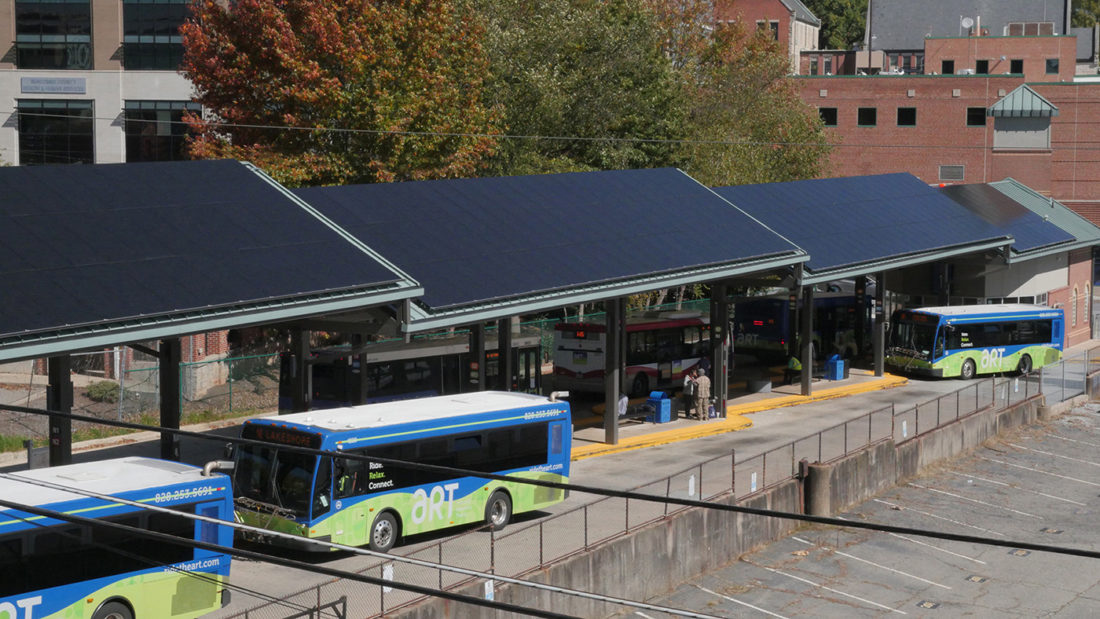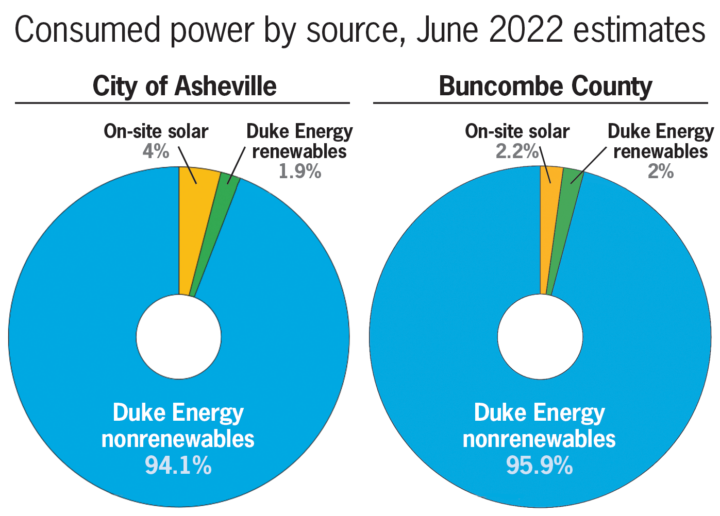The clock to 2030 is ticking.
Both Buncombe County and the city of Asheville have resolved that, by the end of that year, government operations will be powered entirely by renewable energy. A 2019 report produced by The Cadmus Group, a Massachusetts-based consulting firm, laid out numerous ways for the two local governments to achieve those goals.
Perhaps in keeping with Western North Carolina’s crafty ethos, the first strategy Cadmus listed for both governments was a do-it-yourself approach: install, own and operate renewable energy projects. Asheville and Buncombe leaders have proceeded to place solar panels on everything from fire stations and downtown’s bus depot to libraries and a county training facility.
Since then, local and global officials have only reiterated the importance of solar power and other renewable sources as ways to replace fossil fuels and combat climate change. Asheville adopted a climate emergency resolution in 2020; in 2021, U.N. Secretary-General António Guterres said the current and predicted effects of global heating “must sound a death knell for coal and fossil fuels, before they destroy our planet.”
With the long summer days providing peak sunshine hours for those solar panels to pump out power, Xpress wanted to check in on the city and county. How much renewable energy are local governments making — and how much more will they need to reach their policy targets?
Sunshine request
Asheville and Buncombe provided production figures for all government-owned solar facilities from June 6 through July 6, covering the two weeks on either side of the June 21 summer solstice. That monthlong period represents the maximum solar energy theoretically available to the panels, barring interference from weather conditions.
For Asheville’s five solar facilities, that figure came to about 29.84 megawatt-hours. The most productive set of panels was on the Asheville Rides Transit station, which produced 8.84 MWh, about 30% of the city’s total. (For comparison, the average North Carolina household consumed about 1.04 MWh per month in 2020, according to the U.S. Energy Information Administration.)
Buncombe County’s total production over the same period from its own five solar installations was about 25.04 mWh. The Leicester Library facility led the pack with 5.35 MWh generated, about 21% of the county total.
In demand
Due to the way Duke Energy bills local governments, Xpress wasn’t able to directly compare solar production with overall energy use over the same June 6-July 6 period. But Asheville and Buncombe were able to provide rough figures for previous summers, which were used to estimate government-wide monthly power consumption.
Across all Asheville government buildings, monthly summer power use in 2021 was roughly 746.6 MWh. For Buncombe County, the average June electricity consumption in 2020 and 2021 was 1,150 MWh.
So, how much does local government’s production during peak solar season offset its needs? Based on these averages, Asheville covers roughly 4% of its electricity consumption through solar, with Buncombe covering about 2.2%. The remaining power comes from the Duke Energy grid; as of 2021, approximately 2% of Duke’s production came from renewable sources such as hydroelectricity and solar.
On target?
The Cadmus report did not suggest that local governments should cover all of their energy use with on-site solar alone. However, it proposed that Asheville and Buncombe County could meet roughly 20% of their renewable energy needs through “feasible and prioritized” or “planned” local actions — significantly more than the current state of affairs.
Asked about the city’s progress toward its goal, Sustainability Director Bridget Herring struck an upbeat tone. “I am proud of the steps City Council and the organization has taken to date,” she said. “While we know from the Moving to 100% report that there is not enough rooftop space or city-owned property to meet the 100% renewable energy goal on-site, I believe the city should continue to pursue feasible on-site renewable energy projects because it maximizes the public benefit through both the local environmental impact and economic impact of reduced utility costs.”
Jeremiah LeRoy, Buncombe County’s sustainability officer, was similarly optimistic. “I am very excited about the tremendous progress that the county has made toward reaching its 2030 goal. With the significant commitments that our Board of Commissioners has made in clean energy projects, we are tracking toward being over 40% of the way toward meeting the 2030 goal, with many more opportunities to continue to improve that trajectory.”





Our City and County’s ambitious promises to operate on 100% renewable energy by 2030 can be reached by careful investments in 3-10x energy efficiency, beneficial electrification of buildings and fleet vehicles, flexible demand response IT systems, onsite solar energy generation, thermal and electric energy storage, and behind the meter Microgrids. Microgrids are the secret weapon for orchestrating the stacked benefits and savings of these investments. The whole system, integrating complementary hardware and software, is greater than the sum of its parts.
Addressing the rational anxieties of young people who are concerned about our future, while preparing for the known knowns of climate change, can create Applied Hope for actually leaving our world better than we found it. Engage!
The next big thing is to integrate these investments in rooftop and canopy solar generation into resilient systems that orchestrate thermal and electric energy storage, 3-10x energy efficiency, beneficial electrification of buildings and vehicles, flexible demand response IT controls, and behind the meter Microgrids. The benefits and savings of the whole are definitely greater than the sum of their parts.
There are two very major problems with the idea that solar energy can solve all of our problems.
1) There is no cost effective (i.e., not energy intensive) method for storing solar electricity to be used when the sun doesn’t shine. And on the scale of our current energy demands.
2) Solar energy (and wind for that matter) is so unpredictable that operating a reliable grid without serious fossil or nuclear fueled backup is not feasible.
The only real solution to the world’s climate change crisis is to start seriously reducing our energy consumption. Of course that means loss of elements of comfort and convenience in our lifestyle and more importantly loss of lots of current-type jobs. We are going to have to move back to a slower, much more sustainable lifestyle; one that is largely built by hand. Solar can help supplement in that new age but solar can never replace our current system. Not very “techie”. Not very sexy. Probably why no one much wants to contemplate or talk about it.
Defining the problems to be humanly scalable, and therefore digestible, will permit integrating the cheapest things into affordable systems to become parts of the solution. Making up straw men to attack is never very helpful, but always easy on social media.
Spot on, Mike.
Agree with much of this and yet our local ‘leaders’ keep pushing car dependent housing projects, among so many other dumb decisions…